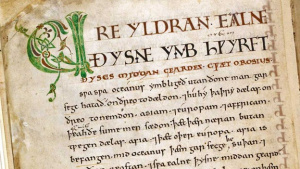Difference between revisions of "Language/Latin/Grammar/Negation"
(Undo revision 147201 by Maintenance script (talk)) Tag: Undo |
m (Quick edit) Tag: Reverted |
||
| Line 1: | Line 1: | ||
{{ | {{Old-english-ca-450-1100-Page-Top}} | ||
<div class="pg_page_title"> | <div class="pg_page_title">Old English (ca. 450-1100) Grammar - Gender</div> | ||
Hi [https://polyglotclub.com/language/ | Hi [https://polyglotclub.com/language/old-english-ca-450-1100 Old English (ca. 450-1100)] learners! 😊<br>In this lesson, we will be discussing the gender of nouns in Old English (ca. 450-1100). We will look at the different genders and how to identify them. We will also look at some examples of nouns in each gender. | ||
__TOC__ | |||
== | ==Genders== | ||
Old English (ca. 450-1100) has three genders: masculine, feminine, and neuter. The gender of a noun affects the form of the article and the adjectives that are used with it. | |||
===Masculine=== | |||
Masculine nouns are usually used for male people or animals, but they can also be used for things such as ships and tools. Masculine nouns usually end in -a or -e. | |||
===Feminine=== | |||
Feminine nouns are usually used for female people or animals, but they can also be used for things such as plants and countries. Feminine nouns usually end in -o or -u. | |||
===Neuter=== | |||
Neuter nouns are usually used for things such as objects and ideas. Neuter nouns usually end in -n or -m. | |||
==Examples== | |||
Here are some examples of nouns in each gender: | |||
== | |||
{| class="wikitable" | {| class="wikitable" | ||
|- | |- | ||
! | ! Old English (ca. 450-1100) !! Pronunciation !! English Translation | ||
|- | |- | ||
| | | cyning || /ˈkiː.niŋ/ || king | ||
|- | |- | ||
| | | cwene || /ˈkweː.ne/ || queen | ||
|- | |- | ||
| | | hūs || /huːs/ || house | ||
|} | |} | ||
==Quiz== | |||
Test your knowledge of Old English (ca. 450-1100) gender with this quiz: | |||
# What is the gender of the noun ''cyning''? | |||
# What is the gender of the noun ''cwene''? | |||
# What is the gender of the noun ''hūs''? | |||
==Answers== | |||
# Masculine | |||
# Feminine | |||
# Neuter | |||
==Conclusion== | |||
In this lesson, we have looked at the three genders of Old English (ca. 450-1100): masculine, feminine, and neuter. We have also seen some examples of nouns in each gender. | |||
Remember, you can use the [https://polyglotclub.com Polyglot Club] website to practice your Old English (ca. 450-1100) [[Language/Old-english-ca-450-1100/Grammar|Grammar]]. [https://polyglotclub.com/find-friends.php?search=send&d=0&f=36&offre1=5277 Find native speakers] and ask them any [https://polyglotclub.com/language/old-english-ca-450-1100/question questions]! | |||
<hr>➡ If you have any questions, please ask them in the comments section below.<br>➡ Feel free to edit this wiki page if you think it can be improved. 😎 | |||
== | {{#seo: | ||
|title=Old English (ca. 450-1100) Grammar - Gender | |||
|keywords=Old English, ca. 450-1100, Grammar, Gender, Masculine, Feminine, Neuter | |||
|description=In this lesson, we will be discussing the gender of nouns in Old English (ca. 450-1100). We will look at the different genders and how to identify them. We will also look at some examples of nouns in each gender. | |||
}} | |||
{{Old-english-ca-450-1100-Page-Bottom}} | |||
Revision as of 22:51, 25 February 2023
Hi Old English (ca. 450-1100) learners! 😊
In this lesson, we will be discussing the gender of nouns in Old English (ca. 450-1100). We will look at the different genders and how to identify them. We will also look at some examples of nouns in each gender.
Genders
Old English (ca. 450-1100) has three genders: masculine, feminine, and neuter. The gender of a noun affects the form of the article and the adjectives that are used with it.
Masculine
Masculine nouns are usually used for male people or animals, but they can also be used for things such as ships and tools. Masculine nouns usually end in -a or -e.
Feminine
Feminine nouns are usually used for female people or animals, but they can also be used for things such as plants and countries. Feminine nouns usually end in -o or -u.
Neuter
Neuter nouns are usually used for things such as objects and ideas. Neuter nouns usually end in -n or -m.
Examples
Here are some examples of nouns in each gender:
| Old English (ca. 450-1100) | Pronunciation | English Translation |
|---|---|---|
| cyning | /ˈkiː.niŋ/ | king |
| cwene | /ˈkweː.ne/ | queen |
| hūs | /huːs/ | house |
Quiz
Test your knowledge of Old English (ca. 450-1100) gender with this quiz:
- What is the gender of the noun cyning?
- What is the gender of the noun cwene?
- What is the gender of the noun hūs?
Answers
- Masculine
- Feminine
- Neuter
Conclusion
In this lesson, we have looked at the three genders of Old English (ca. 450-1100): masculine, feminine, and neuter. We have also seen some examples of nouns in each gender.
Remember, you can use the Polyglot Club website to practice your Old English (ca. 450-1100) Grammar. Find native speakers and ask them any questions!
➡ If you have any questions, please ask them in the comments section below.
➡ Feel free to edit this wiki page if you think it can be improved. 😎
